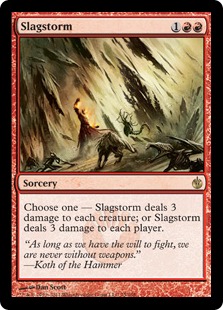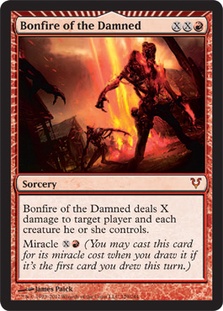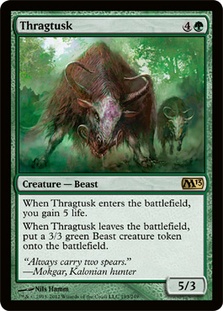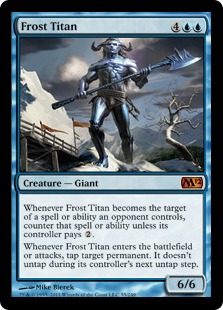I made my first foray back into Standard last weekend at the StarCityGames.com Open Series in Buffalo. And what a difference a few weeks can make! When last I played, you could hardly use the bathroom without being harassed by Insectile Aberrations and Geists of Saint Traft, but that no longer seems to be the case. While a handful of dedicated Delver players simply refuse to lie down, today’s Standard metagame is about creatures, creatures, and more creatures. Not just any creatures, though. The smaller, the dumber, and the greener, the better!
Creatures (31)
- 4 Llanowar Elves
- 4 Birds of Paradise
- 4 Elvish Visionary
- 4 Elvish Archdruid
- 4 Arbor Elf
- 1 Ezuri, Renegade Leader
- 2 Village Bell-Ringer
- 4 Restoration Angel
- 1 Craterhoof Behemoth
- 3 Soul of the Harvest
Lands (21)
Spells (8)

Creatures (28)
- 4 Birds of Paradise
- 4 Hero of Bladehold
- 4 Blade Splicer
- 4 Avacyn's Pilgrim
- 3 Strangleroot Geist
- 4 Thalia, Guardian of Thraben
- 3 Restoration Angel
- 2 Silverblade Paladin
Planeswalkers (3)
Lands (23)
Spells (6)

Creatures (29)
- 4 Birds of Paradise
- 2 Elvish Visionary
- 1 Acidic Slime
- 2 Borderland Ranger
- 1 Inferno Titan
- 1 Manic Vandal
- 1 Phyrexian Metamorph
- 3 Blade Splicer
- 1 Fiend Hunter
- 4 Avacyn's Pilgrim
- 1 Thalia, Guardian of Thraben
- 1 Huntmaster of the Fells
- 3 Restoration Angel
- 1 Zealous Conscripts
- 1 Wolfir Silverheart
- 1 Sublime Archangel
- 1 Thragtusk
Lands (24)
Spells (7)
Sideboard
- 1 Ancient Grudge
- 1 Celestial Purge
- 1 Wurmcoil Engine
- 1 Elesh Norn, Grand Cenobite
- 1 Sword of War and Peace
- 1 Stingerfling Spider
- 1 Daybreak Ranger
- 1 Thalia, Guardian of Thraben
- 1 Crushing Vines
- 1 Bonfire of the Damned
- 1 Zealous Conscripts
- 1 Wolfir Silverheart
- 1 Angel of Glory's Rise
- 1 Yeva, Nature's Herald
- 1 Thragtusk

One approach to a field like this one is to choose a creature deck yourself. You could play Delver, Zombies, or whatever flavor of Birthing Pod tickles your fancy. You could learn your matchups well, play tight, and maybe find a sideboard card or two to help you out against all the other Birthing Pod and G/W Swarm players out there. But that’s the hard way.
The easy way—the best way—is not to play their game at all. Why play fair when you can just go over the top and trump whatever the opponent is doing? Why fight through each Blade Splicer token and every recurrence of Strangleroot Geist when you clean them up all at once in a terrifying, but strangely satisfying, inferno?
Why choose a deck where every Gut Shot, Huntmaster of the Fells trigger, and Bonfire of the Damned miracle will ruin your day? These are cards that all of your opponents will have because they are the best tools available to fight the creature-heavy metagame. You can ignore them all by using a strategy that doesn’t rely on or care about weenie creatures.
Creatures (15)
Lands (26)
Spells (19)

Wolf Run Ramp quietly held its rank among the top decks for the entire lifespan of this Standard format, right from the release of Innistrad. While it often doesn’t get the respect it deserves and has rightly earned, it tends to reemerge to win high profile tournaments whenever its time is right, such as at 2011 Worlds, Pro Tour Dark Ascension, and GP Orlando.
Now, the time is right again. Wolf Run Ramp simultaneously preys on smaller creature decks and completely ignores the hate cards targeting them. It has historically hovered around 50/50 against U/W Delver, but with the new additions of Cavern of Souls and Thragtusk, there’s no reason to fear the matchup.
All metagame concerns aside, the simple existence of Thragtusk, a single card, would be enough to make me play Wolf Run Ramp. Thragtusk is among the best cards printed in recent memory, and what makes the card even more remarkable is its universal applicability. It’s modestly costed and requires only a single green mana, so nearly any deck could use it if they wanted to. The guaranteed value from its "enters" and "leaves" the battlefield triggers makes it useful against any opponent, no matter how many Vapor Snags, Doom Blades, and Day of Judgments they’re packing.
That said, it shines in a special way in Wolf Run Ramp. The deck’s strength in the late game means that typically all you want to do is survive, survive, and survive. Thragtusk is a powerful and safe play that typically comes at just the right point in the game. The immediate life gain means you need not fear Zealous Conscripts or Vapor Snag, and the card’s defensive orientation means that if a Delver player copies it with Phantasmal Image (the only way to answer it at parity), the only thing they’ll accomplish is slowing down the game and dragging things out to the advantage of the Wolf Run Ramp player. In combination with Cavern of Souls and Kessig Wolf Run, it’s truly a powerful tool.
Wolf Run is also the only deck that needs not fear a Thragtusk. For obvious reasons, the Beast shuts down aggressive decks in a big way. Even against control, though, the way it generates value after a Doom Blade or Day of Judgment is quite powerful. The only thing the card isn’t great at is killing the opponent quickly, so Wolf Run Ramp has plenty of time to come over the top with a Titan or Wurmcoil Engine.
The G/R Wolf Run Ramp list I’ve offered above is what I believe to be the most rock solid deck choice for this weekend’s StarCityGames.com Standard Open in DC or any other upcoming Standard event. If you expect the metagame to continue on its current track and you expect Delver and G/W Elf Combo to show up in strong numbers, I recommend G/R Wolf Run Ramp.
Regarding the exact decklist, while many people have abandoned Green Sun’s Zenith, I still think it should be a major consideration. Overall, casting a Zenith for a Birds of Paradise on turn 2 is only a little bit weaker than playing a Farseek or Sphere of the Suns; often, it’s exactly the same. The difference comes when you topdeck Green Sun’s Zenith on turn 9, which is somewhat better than topdecking that same Farseek. That said, I’ve tempered my enthusiasm for the card and restricted it to two copies since I don’t like the idea of playing second-best targets like Huntmaster of the Fells and Acidic Slime just for the sake of versatility.
On the topic of Farseek, it is a nice addition to Wolf Run, as Rampant Growth has always been substantially better than Sphere of the Suns. Like Rampant Growth, your mana acceleration from Farseek cannot run out, and it cannot be Ancient Grudged. However, unlike Rampant Growth, Farseek cannot search for a basic Forest. For this particular list, that causes a problem because in order to fit all of the colorless value lands, you either need to cut so low on Mountains that you can’t support Farseek or you need to cut so low on Forests that you can’t cast it on turn 2 with enough consistency. I’ve suggested a split between Farseek and Sphere of the Suns to increase the number of opening hands you can keep (sometimes you can keep a hand with a Sphere but no green land) and decrease the number of times you run out of Mountains to search up.
Farseek can be a much more powerful tool in a three-color Wolf Run Ramp build.
Creatures (15)
- 4 Solemn Simulacrum
- 1 Birds of Paradise
- 4 Primeval Titan
- 3 Wurmcoil Engine
- 1 Elesh Norn, Grand Cenobite
- 2 Thragtusk
Planeswalkers (1)
Lands (26)
Spells (18)

Wolf Run White, while functionally very similar to straight G/R, sacrifices a few of the colorless value lands in exchange for a greater diversity of top-end threats and the all-powerful Day of Judgment.
Slagstorm falls short against Hero of Bladehold and Restoration Angel. Bonfire of the Damned is bad to see in your opening hand. Blasphemous Act can be overpriced and inefficient. Day of Judgment does all of their jobs, it does them under any circumstances, and it does them all the way.
Oblivion Ring is also a card I would be happy to have in my maindeck in the course of a long tournament. Annoying noncreatures like Birthing Pod, equipment, and opposing Oblivion Rings make me want to maindeck a utility card in Wolf Run Ramp, but the options available to straight G/R are not so appealing. Natural End and Crushing Vines are considerations but would frequently be stuck in your hand with no target. Acidic Slime is expensive and competes with the dramatically better Thragtusk for a spot on the mana curve. Beast Within is a great sideboard card for certain matchups, but it’s simply too bad against creature strategies to maindeck, in my opinion. Oblivion Ring, though sorcery speed, is a versatile answer that will never be completely dead.
If you expect midrange green decks like Birthing Pod to continue their dominance, I recommend Wolf Run White. In particular, having easy answers to Hero of Bladehold corrects one of the few weaknesses of Wolf Run Ramp that such creature decks will try to exploit.
Creatures (14)
- 3 Solemn Simulacrum
- 1 Birds of Paradise
- 2 Frost Titan
- 4 Primeval Titan
- 2 Phantasmal Image
- 1 Huntmaster of the Fells
- 1 Thragtusk
Lands (26)
Spells (20)

Wolf Run Blue is a deck recently popularized by Josh Ravitz and Gerard Fabiano. It’s also the deck I played to a 7-2 record at the StarCityGames.com Standard Open in Buffalo.
While I can certainly say that I wasn’t disappointed with the blue, I’ll also admit that I’m not 100% confident in it either. The honest truth is that it was the general strengths shared by all flavors of Wolf Run Ramp that really impressed me and led to my success.
Ponder is a welcome addition to nearly any deck, but with only eight blue lands, it doesn’t have the same power to smooth out your early turns as it does in U/W Delver. Temporal Mastery was remarkably powerful in certain matchups and was always a solid game 1 card, but it was typically the first thing I looked to sideboard out.
I did feel that Frost Titan was an improvement over the Wurmcoil Engines I’ve suggested in the other two decklists (though Gerard, with whom I worked on the deck, wasn’t as sure on this point). Phantasmal Image serves as one more answer to Geist of Saint Traft and is powerful for obvious reasons in a deck that plays six Titans. Negate out of the sideboard is a blowout against blue control and some other miscellaneous decks.
As I mentioned above, I feel that Green Sun’s Zenith is at least a consideration, but the Huntmaster of the Fells and Melira, Sylvok Outcast were bad for me. I wished I’d had more Thragtusks and more Cavern of Souls, at least in the sideboard. With the recent success of Elves and the annoying persistence of U/W Delver, I would also recommend a couple of Whipflares somewhere in the 75.
Wolf Run Blue maintains all of the strengths of traditional Wolf Run Ramp but has a few extra tools for the matchups that are traditionally difficult for the archetype. If you expect the metagame to take a turn back towards control and Wolf Run mirrors, I recommend Wolf Run Blue.
Any of the above decks are great options for Standard right now. They are substantial favorites over the vast range of green beatdown decks that are coming to define the format. Equally important, though, is the way they dodge the hate targeted towards these decks.
Of course, you can feel free to slog it out in creature battles with everyone else. If you have a great day and are a great player with a great list, you might just rise to the top. I, for one, though, am going to make things easy on myself. I’m not going to play the game that everyone else wants me to play. I’m going to Run people over!





